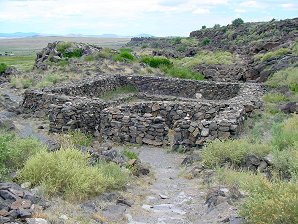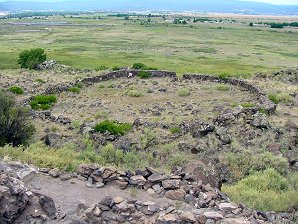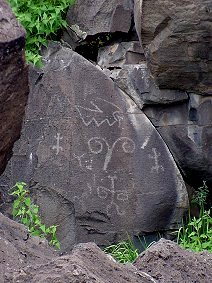Casa Malpaís facts for kids
|
Casa Malpaís Archaeological Park and Museum
|
|

The Kiva
|
|
| Lua error in Module:Location_map at line 420: attempt to index field 'wikibase' (a nil value). | |
| Nearest city | Springerville, Arizona |
|---|---|
| Built | 1240 |
| NRHP reference No. | 66000936 |
Quick facts for kids Significant dates |
|
| Added to NRHP | October 15, 1966 |
| Designated NHL | July 19, 1964 |
Casa Malpaís is an amazing ancient place in Arizona, near the town of Springerville. It's an archaeological site, which means it's where scientists study old human history. This special place was once home to the Ancestral Puebloans, who were early Native American people. Because it's so important, Casa Malpaís was named a National Historic Landmark in 1964.
Contents
Exploring Casa Malpaís: An Ancient Pueblo Site
Casa Malpaís was built around the year 1260. People lived here until about 1400. This means it was used during the Pueblo III Era and Pueblo IV Era of ancient Pueblo history. It's one of the last known places where the Mogollon culture lived. The name "Casa Malpaís" comes from Spanish and means "House of the Badlands."
The area around Springerville has many volcanoes. There are over 400 volcanoes within 50 miles of the town. This makes it the third-largest volcanic field in the United States. The cliffs at Casa Malpaís were formed from ancient lava flows.
What Makes Casa Malpaís Special?
This site has many unique and interesting features. The most important is the Great Kiva. A kiva is a special room used for ceremonies by Pueblo people. This kiva was carefully built using volcanic rock.
To reach the top of the mesa (a flat-topped hill), there's a steep staircase. This staircase is made of basalt rock and is built into a crack in the high cliff wall.
Both the Hopi and Zuni tribes still see Casa Malpaís as a sacred place. It is important to their history and traditions.
The pueblo sits on terraces in front of basalt cliffs. It is about 7,000 feet above sea level. Around 1240, the people built a pueblo with 60 rooms. They also built a solar calendar and the Great Kiva. It is thought that the site was left empty by 1350.
Treasures from the Past: Artifacts
Over time, many artifacts have been found and collected here. These include 156 boxes of broken pottery pieces, called potsherds, and other items. Most of the artifacts found in the 1990s are now on display. You can see them at the Casa Malpaís museum.
The Ancient Solar Calendar
This special calendar is a low stone wall that forms a circle. It is about 26 meters wide and has five openings, like gates. Parts of the wall have been rebuilt. It was likely about 1.2 meters tall.
One opening on the north side seems to point directly north. Another opening on the southwest side is set up to let a special rectangular light shine through. This light hits the wall during sunset on the summer solstice. The summer solstice is the longest day of the year.
During the winter solstice, the shortest day of the year, light also enters this gate. It reaches about the middle of the circular area. On the spring and fall equinoxes, when day and night are equal, the sun again creates a clear rectangular light.
Outside this circular calendar, there is a "Bear Claw" petroglyph. A petroglyph is an image carved into rock. At sunset on the spring equinox, a shaft of light from natural rocks perfectly lights up this bear claw. Both the Hopi and Zuni people have bear clans or societies. They might have created this image for reasons we don't fully understand today.
How Casa Malpaís Was Discovered
The first professional scientist to visit Casa Malpaís was Frank Cushing. He was an anthropologist who studied human cultures. In 1883, he visited a site near the Little Colorado River. He was very impressed by the "fissure type pueblo" he found. A fissure pueblo is built over cracks in the rock. In his journal, he drew how the pueblo was built using dry stone walls over these cracks.
Visiting Casa Malpaís: Museum and Tours
The Casa Malpaís Visitor Center and Museum is in Springerville, Arizona. It is run by the City of Springerville. The museum shows many of the artifacts found at Casa Malpaís. It also offers guided tours of the ancient site. These tours start at the museum.
See also



